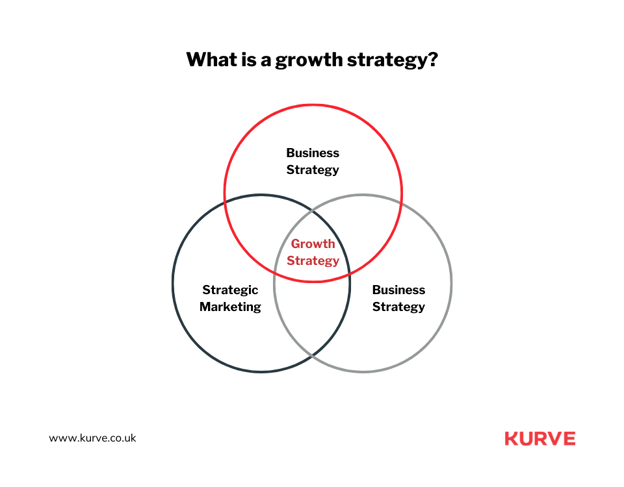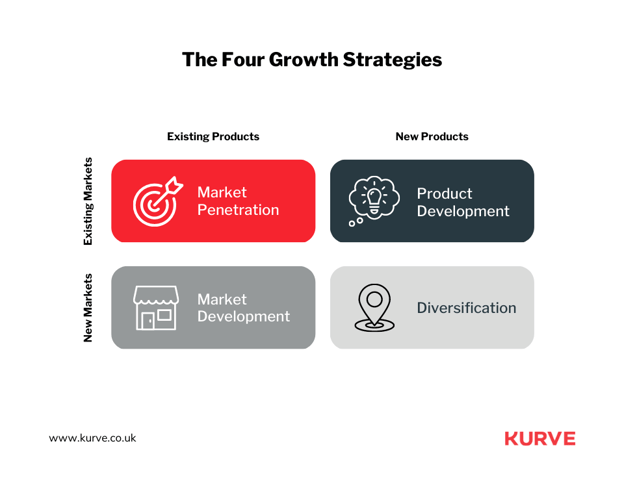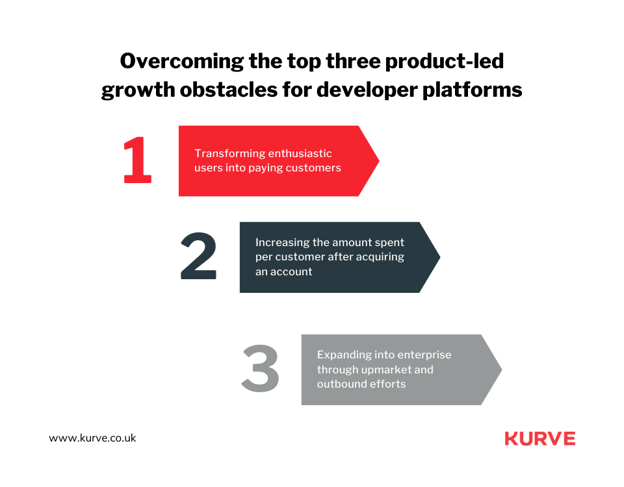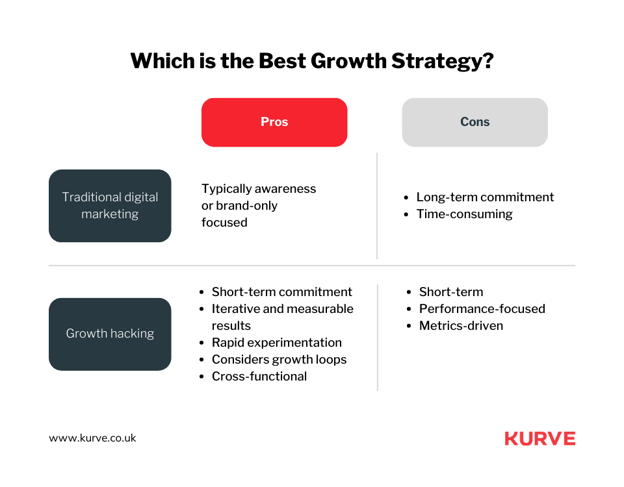What are the 4 Growth Strategies?
Growing a business is a complex task.
With nearly 65% of businesses failing within their first decade, it's clear that a solid growth strategy is essential for survival.
At Kurve, our fractional CMOs understand the importance of crafting a comprehensive growth strategy to help businesses not only survive but thrive. Time and again, after working with our clients, we've seen that an effective growth strategy can help mitigate the typical causes of failure, including issues like lack of product demand, mismanaged marketing or unstable finances.
This article will help you define your growth strategy and explore why having one is essential. We'll also explore the core components and discuss four marketing methods from the Ansoff Matrix that businesses can use to drive their growth strategy.
What is a growth strategy?

A growth strategy is a plan to increase a business's size, revenue, and value.
It's holistically defining how you will win a race against your competition and identifying the most efficient way of reaching that result. A good strategy contains three elements:
- Diagnosis of the challenge
- Guiding policy
- Coherent action
Diagnosis considers the entire process, studying your competition and understanding your benchmarks and metrics. This includes marketing analysis of customers and understanding how to drive engagement within each audience.
A well-built guiding policy defines, articulates, and communicates the process and the ideal destination – what actions are required to meet each milestone.
Finally, the coherent action gets into the finer details like tactics, operations, and governance. A good growth strategy will consider all three elements and their components.
Who needs a growth strategy?
A growth strategy is essential for any business, regardless of its size or industry.
Without a solid plan for expansion, companies risk stagnation or decline. From startups to large enterprises, a growth strategy helps businesses focus on their goals, target market and sustainable growth.
It's particularly crucial for organizations facing market competition, financial challenges or changing consumer demands. In short, every business that wants to thrive and succeed in the long term requires a growth strategy.
The four growth strategies
Today, growth strategies follow an evolved outlook, like the Ansoff Matrix – one of many we use.
The Ansoff Matrix is used to identify potential organizational or brand strategies. The matrix helps business owners understand their current system better and analyze the risks associated with adopting a new plan. Risk increases each time you move into a new approach with varying tactics to achieve growth.

Ansoff's matrix has two axes: one focuses on the product and the other on the market. Sales, development and marketing teams work similarly, with one department investigating which products to offer in the future while the additional considering whom they want to serve.
If you've studied growth before, you will know the "Four P's;" Product, Placement, Promotion and Price. Where the Four Ps focus on audiences, channels and pricing, the Ansoff Matrix is more effective for a broader view of markets and uses the older Four P framework within each of the 4 Ansoff quadrants.
The goal is to use marketing as the foundation of your strategy but harness data, design and product to work as a single interactive unit for long-term success.
Market Penetration
Market penetration is considered a low-risk strategy. A company using market penetration will attempt to expand the sales volume of its current products in its already established markets to increase its total market share.
Often confused with market development, market penetration encourages brand loyalty and customer retention by using marketing material to engage customers using existing products or services.
You can achieve this through price reductions or bundles that lure customers away from competitors or create higher-quality creative content that generates more quality leads. Or, you can explore ways to target existing customers and audiences through new products and services.
Market Development
Market development is a high-risk strategy that can yield significant returns, and you should only consider this strategy when you possess enough capital and resources.
Unlike market penetration, market development is about expanding or retargeting. To create a market development strategy, you should conduct extensive market research to identify market segments - small batches of people in a larger population grouped by labels. You can build these segments around location, age, income, or industry identifiers.
Once you've selected your ideal market segment, you must create a marketing and branding strategy that advertises your existing product or service to attract a new type of customer. Try attracting new customers and markets by finding further uses for a current product or adding new features and benefits.
Within SaaS, market development growth strategy has become a collaborative effort between product and marketing teams. Internal alignment is essential for this strategy, as every new product or service needs to be on-brand and aligned with messaging goals.
Product development
Product development is a strategic approach to growth that focuses on creating and commercializing new products. Instead of increasing market share, it focuses on improving your product line to attract more clients in your existing market segment.
Imagine a dessert restaurant that only serves ice cream. Expanding their menu to include waffles could increase existing customers' buying rates from their business.
To determine new products, you should undergo extensive consumer research focusing on demands and competitor analysis. Product development requires a solid cross-functional collaboration between teams to be successful.
Diversification
Diversification is the riskiest of the four growth options. This strategy involves introducing a new product into an entirely new market, where you may need more experience. This could include deploying products in new geographic areas and translating the benefits of your products to the local population.
Without support from growth marketing experts, failure is a distinct possibility, although the potential of a high payoff may be worth the risk.
Implementing a diversification strategy in an industry facing an extreme financial downturn or a company losing significant market share within a core part of its business may help prevent further damage or closure. When markets are challenging, and competition is fierce, many companies choose to protect their core business while simultaneously exploring new possibilities.
Connecting growth strategy to your growth marketing
Aligning your growth strategy with your marketing efforts can help you understand your next move.
At Kurve, we've developed a " Kurveology " process to guide us through the growth marketing strategies to help scale our clients' businesses.

Strategy
Develop and define the unique qualities that differentiate you from your competitors, emphasizing the most relevant customer segments and how your product's unique attributes best meet their needs.
Research and study your consumers to understand their pains, fears and worries, and link that to your service offering and how your products can help solve their pinch points.
Then, consider your brand, where you want to go, whom you want to target and how you appear. Understanding your customers is essential, but defining your company is vital.
Create a story that resonates with your audience. The SaaS market is saturated with an abundance of information and voices. To break through the noise, you must use a sophisticated strategy that says the right things to the right people at the most reasonable time.
Things to consider while strategizing:
- Target Audience
- Client Journey Mapping
- Funnel Mapping
- Messaging Framework
- Technology Stack
Landscape
Conducting research on the state of your industry and competitor analysis is the best way to determine if your desired marketing growth strategy is necessary and feasible. Understanding your competitor set within the marketing context allows you to differentiate your products and services in a similar customer segment. This includes:
- Their messaging – How do they speak about themselves?
- Their creative direction – Who are the brand colors, language and products connecting with?
- Their distribution –What marketing channels do they operate on?
The knowledge and facts you uncover in this step will shape the targets and KPIs for your marketing strategy evaluation to understand the outcome better.
Following competitor and industry analysis, develop a messaging framework based on your current brand positioning. This will include a map of common customer challenges and how they impact business, and then think about how your product might solve them.
Implementation
Executing your marketing strategy starts with identifying how and where you will place your message that will be most effective for generating leads or driving sales. For SaaS businesses, some of the top distribution channels and methods include:
- Paid ads
- Affiliates
- Freemium pricing
- Community building
- Outbound/cold outreach
- Content marketing
- Value-added resellers
- Search Engine Optimisation
- App Store/app exchanges
- Lead magnets
- Email Marketing
- Podcasts
- Community PR
With all of your planning, resourcing and goal-setting complete, you're ready to execute your growth marketing strategy and deliver results for the business.
Ensure that your onboarding process is closely tied to the customer's buying cycle, aligning internal teams like marketing and sales to ensure an efficient onboarding process. Continuously compare results to your forecasted growth goals to see if your projected outcomes are still achievable or if anything needs to be adjusted.
Evaluation
With your campaign complete and your strategy reaching the end of its cycle, it's time to analyze your results against your original KPIs, individual channel performance KPIs, and growth goals. What went well? What didn't go so well? What can you do better next time?
You can now revert to step one and develop a new, more informed strategy for your next growth marketing drive using your established metrics and numbers.
How to Create a Growth Strategy

Study Your Business Goals
Before creating a growth strategy, it's essential to understand your business goals.
Knowing your goals will help you create a strategy that aligns with your overall vision for your company. Take some time to define what success looks like for your business.
Is it increasing revenue, expanding your customer base or something else? Once you understand your goals, you can move on to the next step.
Conduct Market Research
To identify growth opportunities, you need to conduct market research. Start by identifying your target market and understanding their needs and pain points.
Study industry trends and watch your competitors to see what they're doing; use data and analytics to uncover insights and opportunities.
This will help you create a growth strategy based on real-world information.
Collect Growth Ideas
Generating growth ideas can come from various sources, like a brainstorming session with your team, customer feedback or market research. Once you have a list of potential growth ideas, prioritize them based on their potential impact and feasibility.
Consider the cost, time and resources required to implement each idea.
Decide on KPIs
Key Performance Indicators (KPIs) are metrics you use to measure the success of your growth strategy.
Choosing the right KPIs is critical to ensure you track the right things. Some examples of KPIs include revenue growth, customer acquisition cost, and customer lifetime value.
Choose KPIs that align with the business goals that you can appropriately measure.
Execute and Evaluate
Once you have a growth strategy, it's time to execute it. This can involve tactics like product development, marketing campaigns, or partnerships.
Make sure you have the plan to measure your strategy's success. Monitor your KPIs regularly and adjust your system as needed.
Try to derive insights regularly by learning from your successes and failures. You should then use that data to improve your techniques.
Scale up on Winners
As you execute your growth strategy, you'll start to see some tactics that are more successful than others. When you identify a winning strategy, scale it up.
Allocate more resources to it and continue to optimize it for even better results. Scaling up successful strategies is vital to growing your business over the long term.
By following these steps correctly, you will have tailored growth for your business to set you up for success.
Which is the Best Growth Strategy?
There are several different growth marketing strategies that you could use to increase your market share, including:
- Viral loops - A viral loop funnel requires a single satisfied user to share with others instead of needing as many leads as possible at the top of your sales funnel.
- Milestone referrals - Businesses that use milestones offer rewards for hitting specific benchmarks. In many cases, "milestones" are metrics like the number of referred friends.
Some traditional strategies are rigid and follow a defined order and structure. However, advanced marketing teams are now taking a slightly different approach: growth hacking. Growth hacking is a method that uses strategies focused on speed and quick results.
We prefer to encourage collaboration between Product, Marketing, Engineering and Data to build plans based on concrete evidence rather than anecdotal, with accurate data-based measurements, instead of buzz and perception.

There is no one-size-fits-all answer to the best strategy for your business. Each company is unique, with its goals, resources and market conditions.
Given your market conditions, the key is choosing a growth strategy that aligns with your business goals and resources and has the best chance of success. Consider factors like your target audience, competition and available resources when deciding.
Remember, the best growth strategy for your business is the one that helps you achieve your goals and set you up for long-term success.
Finding the right approach for you?
Without a sound growth strategy built on data and expert industry knowledge, your business is in jeopardy. To ensure your company thrives, you must create a unique business growth plan that aligns with your ambitions, product and brand position.
Using the Ansoff Matrix to guide the planning process can help identify new marketing opportunities while reminding you of the potential risks and dangers that new strategies can bring when implemented poorly. Pay attention to your metrics, listen to your audience and monitor your product. Learning is your first step in defining your next growth strategy.
Our performance-oriented approach constructs strategies on the core pillars of marketing and business growth strategy but is nuanced and bespoke to your industry and goals.
Let us help you build an effective growth strategy. Contact our team of experts today.


